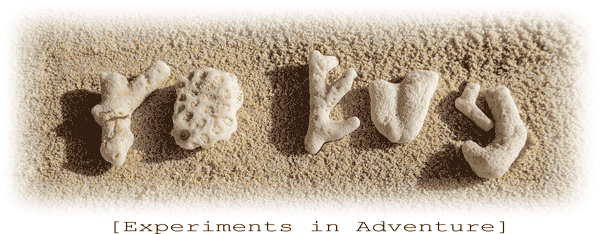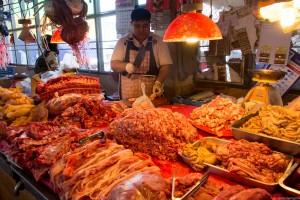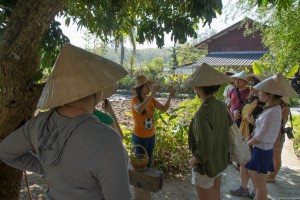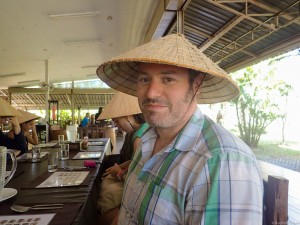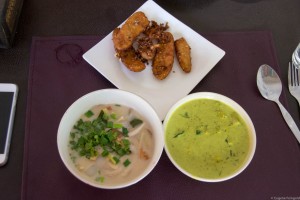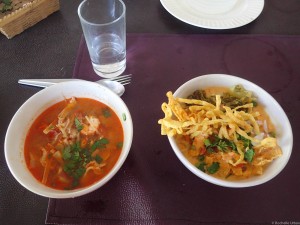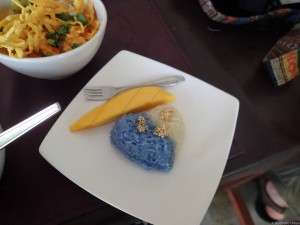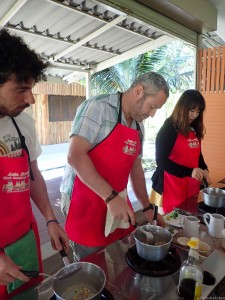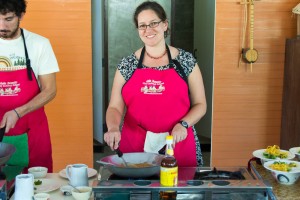When we reached Chiang Mai, Eugene and I decided to take a cooking class as we wanted to learn about the food we’d been eating over the last week in Thailand. Cooking schools are all over the old city of Chiang Mai and Eugene’s friend recommended us one that takes us out to a farm.
Our instructor, Meow (yes, really), picked us up from our hotel and we made our way out to the farm with a stop at a local food market. At the market, we learned about many of the ingredients we’d be using. Though for many farang (foreigners) this would be full of exotic new fruits and vegetables, Eugene and I were reminded of Berkeley Bowl and how lucky to live in the Bay Area with the vast diversity of produce.
Once at the farm, we donned ridiculous farm hats to explore even more of the fresh ingredients we’d be using. We learned a few useful things, like the difference between kaffir limes (only the rind and leaves are used) and regular limes (the juice and sometimes rind is used) as well as the Thai word for squash – fak (sounds exactly how you think). I also discovered that the fresh looking ginger I’d seen at the store in the US is called galangal and is similar to ginger, but less spicy and more sweet.
- Requisite cooking class stop at the market.
- Meat market, offal anyone?
- Our instructor, Meow, explains he difference between ginger and galangal.
- Looking good in our farm hats
We each got to choose from multiple dishes for each course, so we cooked a total of 10 different things. Eugene made spicy chicken salad, hot basil stirfry, tom kha soup, green curry, and fried banana. I made green papaya salad, pad thai, tom yum soup, khaw soi curry (a specialty of Chiang Mai), and mango sticky rice.
As we began cooking, Meow explained that we can make our food as spicy or mild as we’d like, calling something that was more spicy “sexy.” She definitely had her script down, but was still amusing 🙂
In the preparation of our first courses, Eugene was given the instruction to use some chili peppers. Our instructor told us foreigners use 3-5 peppers and Thais use 10-15. Eugene — having already taken offense at her saying “foreigners don’t eat that” about black (blood) tofu at the market — said “Ok, I’ll use 25!” It was definitely quite sexy, but still quite edible.
We also learned to make curry paste from scratch, using a mortar and pestle. My chili paste, khaw soi, uses dried red chilis, lemongrass, ginger, turmeric, and many other aromatics all mashed together. Eugene made green curry paste, made with fresh chilis and therefore hotter. It took a lot of work to make the paste.
- Eugene’s meal of tom kha, green curry, and fried banana
- Rochelle’s Tom Yum soup and Khaw Soi
- Mango sticky rice – the blue color is from a flower.
- Eugene making incredibly spicy chicken salad
- Making some khaw soi curry
We are excited to try cooking the dishes we made once we are done with our adventures and to be even more open to the different fruits and veggies in the Bay Area markets. We are also looking forward to taking cooking classes in all the other countries we visit.
- Asia Scenic cooking school farm pond
- Cooking class at a farm also includes fun in the hammocks
